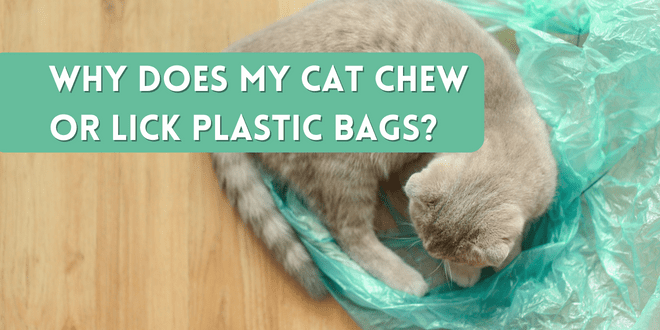
Plastic bags are dangerous to your cat for so many reasons. If chewed, there’s a risk of choking and intestinal blockage. Playing with plastic bags creates a risk of strangulation and suffocation. Not every cat does this behavior but if your kitty does, it can be a seemingly endless battle to keep plastic bags out of reach.
The Appeal of the Plastic Bag
Each cat is different when it comes to the attraction to the plastic bag but there are some common reasons:
Plastic bags contain lubricating chemicals known as “slip agents.” The chemicals contain stearic acid from animal fat. The slip agents are designed to keep bags from sticking together. Some cats may be attracted to the taste or smell of these chemicals.
To cut down on the use of petroleum-based plastic bags, some companies are using biodegradable bags made with products such as corn starch which may attract some cats.
The plastic bags may be appealing due to any retained food smells from the groceries that were inside, especially meat or fish.
Texture is also something to consider when it comes to plastic bag appeal. The smooth, cool surface may be appealing to lick or chew. What might have started as an interesting surface to lounge on may have escalated into licking and chewing.
The crinkly sound of the bag can also be enticing to some cats.
Boredom or Stress Could Play a Role in Why a Cat Chews Plastic Bags
The behavior may have begun because the cat had no stimulation in the environment and chewing on plastic bags provided some activity. Cats who don’t have enough environmental stimulation and adequate play opportunities are more vulnerable to boredom-related behaviors. Perhaps the cat is left alone for too long.
For many animals, chewing is a stress-relieving behavior. A cat who lives in a tense multicat household may have found chewing on plastic to help as a coping mechanism. There are many other stress triggers that can affect cats as well and cat parents may not notice, such as a chaotic environment, changes in the household, changes in the family or changes in schedules.
Medical Issues
The chewing of plastic bags may be connected to mouth pain or a dental problem. Chewing may be a form of pain relief.
There may be a dietary component to the desire to chew on particular objects.
A visit to the veterinarian is needed to rule out any dental issues, dietary problems or other underlying cause for the behavior.
Chewing on plastic is a dangerous behavior so if your cat begins doing this, don’t assume it’s just behavioral. Talk to your veterinarian.
How to Prevent Your Cat from Chewing or Licking Plastic Bags
Plastic bags can be irresistible to your cat due to how light they are and the crinkly sound they make. Never allow your cat to play with them at any time, even if they don’t show any interest in chewing or licking. It’s important to be diligent about keeping bags out of your cat’s reach. Make sure everyone in the household is aware of the importance of this so no bags are left out where your cat can get at them.
Switch to paper or cloth shopping bags to reduce the risk of your cat gaining access to plastic.
Provide daily interactive playtime opportunities for your cat to reduce boredom. Engage in twice-daily sessions that will enable your cat to discover, stalk, pounce and capture “prey.” Use a toy designed like a fishing pole so you can simulate the movements of prey.
In addition to interactive playtime, your cat needs solo playtime opportunities, especially if they spend much time home alone. Use puzzle feeders for either wet or dry food so your cat can have foraging opportunities throughout the day. Strategically place puzzle feeders around your cat’s area so they’ll get to hunt several times. Puzzle feeders for cats can be purchased at your local pet supply store or ordered online. Homemade puzzle feeders are easy to create as well.
Look at the environment itself and see if it needs some cat-friendly sprucing up. Your cat should have a cat tree or some climbing structure for play, rest and for watching the activity outdoors. Think of it as kitty TV. In a multicat household, the addition of cat trees and vertical territory can help in maintaining harmony.
Address stress triggers within your household that may be affecting your cat. If there are multicat issues, work on helping the cats form a more peaceful co-existence. Make sure everyone has safe and easy access to resources. Look at how the feeding station is set up, how many litter boxes you have and their locations. Are the cats having to compete for resources? Does one cat get bullied? In order to effectively address your cat’s urge to chew on plastic you have to address underlying household causes.
Any trash cans lined with plastic bags hanging over the sides should be kept in cabinets.
Keep in mind that it may not just be the plastic grocery bags that are attractive to your cat. Don’t leave plastic bags that store food, such as bread bags, out on the kitchen counter.
Provide Safe Alternatives for Chewing
Consider growing some safe kitty greens for your cat. Many cats enjoy munching on grass and although experts aren’t entirely sure of the reason, it’s a safe behavior. You can buy a growing kit at your local pet product store or online. You can also usually buy a patch of grass at the local organic food store. Don’t give your cat grass from the yard that may be treated with pesticides and fertilizers.
You can also talk to your veterinarian about the use of cat-safe dental chews.
Need More Information?
Remember, if your cat has suddenly started chewing or licking on plastic bags, talk to your veterinarian. If you’re unable to correct your cat’s chewing behavior, your veterinarian may refer you to a veterinary behaviorist or certified cat behavior consultant.
For more information about cat behavior and training, refer to the best-selling books by Pam Johnson-Bennett. Pam’s books are available at bookstores and online. We’ve included Amazon associate links here on our website.
If you have a question about your cat’s behavior or health, contact your veterinarian. This article is not intended as a medical diagnosis nor is it a replacement for your cat’s regular veterinary care. This article is for general information purposes only.



